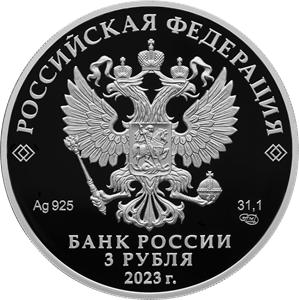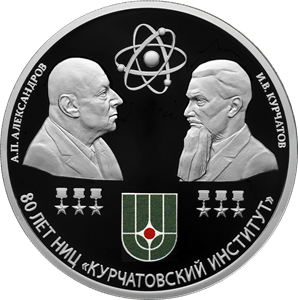The 80th Anniversary of the National Research Centre Kurchatov Institute and the 120th Anniversary of the Birth of Academicians Igor Kurchatov and Anatoly Alexandrov
Obverse
a relief image of the National Coat of Arms of the Russian Federation and a semicircular inscription above it along the rim ‘РОССИЙСКАЯ ФЕДЕРАЦИЯ’ (RUSSIAN FEDERATION) framed with paired diamonds on both sides, under the coat of arms are the chemical symbol of the metal and fineness on the left and fine metal content and the mint trade mark on the right, at the bottom in the centre, in three lines, are an inscription ‘БАНК РОССИИ’ (BANK OF RUSSIA), the coin denomination ‘3 РУБЛЯ’ (3 RUBLES), and the year of issue ‘2023 г.’ (2023).
Reverse
relief images of the portraits of triple Heroes of Socialist Labour academicians Anatoly P. Alexandrov and Igor V. Kurchatov, the Hammer and Sickle gold medals and the symbol of an atom; a coloured image of the emblem of the NRC Kurchatov Institute below; and the relief inscriptions around the circumference ‘А.П. АЛЕКСАНДРОВ’ (A.P. ALEXANDROV) on the left, ‘И.В. КУРЧАТОВ’ (I.V. KURCHATOV) on the right, and ‘80 ЛЕТ НИЦ ‘КУРЧАТОВСКИЙ ИНСТИТУТ’ (THE 80TH ANNIVERSARY OF THE NRC KURCHATOV INSTITUTE) below.
Authors
Designers: E.V. Kramskaya (obverse), A.D. Schablykin (reverse).
Sculptors: A.A. Dolgopolova (obverse), A.N. Bessonov (reverse).
Mint: Saint Petersburg Mint (СПМД).
Edge: 300 corrugations.
Discover more
The Academy of Sciences of the Soviet Union created Laboratory No. 2 on 12 April 1943. It was headed by Professor Igor V. Kurchatov (1903–1960). This day is deemed to be the official date of the establishment of the famous Kurchatov Institute that did not only develop nuclear weapons within a short period, but also gave rise to the civilian nuclear industry.
On 25 December 1946, Laboratory No. 2 launched the nuclear reactor F-1 made of uranium-graphite blocks, which was the first one in Eurasia. Soon, Laboratory No. 2 created plutonium-239. On 29 August 1949, the Semipalatinsk Test Site carried out the first nuclear test, thus breaking up the US nuclear monopoly. Over the six years since its establishment, Laboratory No. 2 managed to attain the objective set by the government, designing the country’s nuclear shield under Kurchatov’s academic supervision.
However, Kurchatov’s goals and ideals were always peaceful. He was among the initiators actively participating in the development of the Soviet Union’s peaceful proposals to prohibit nuclear weapons. ‘As nuclear power scientists, we are aware, like no one else, that the use of nuclear and hydrogen weapons is leading the humanity to numerous evils,’ said Igor Kurchatov. These words are the best expression of his ideas and intentions already during the period of the development of nuclear weapons. His speech at the international conference in Harwell (the United Kingdom) in 1956 was a sensation as the scientist suggested cooperation to his foreign colleagues in the peaceful use of nuclear power.
Even before the development of the bomb was completed, Kurchatov was seeking ways for a broader use of nuclear power for peaceful purposes. The scientist and his employees carried out research in such areas as the nuclear power industry, the fleet, spacecraft and, later on, the space.
On 27 June 1954, under the academic supervision of the Kurchatov Institute, the country launched the first industrial nuclear power plant in Obninsk. Soon after that, the construction of large nuclear power plants started across the country.
Anatoly P. Alexandrov (1903–1994) became the scientific supervisor of the project of the first Soviet nuclear submarine. He was one of the leaders of the Soviet nuclear project and Kurchatov’s closest associate. He headed the development of nuclear submarines of three generations, nuclear-powered surface ships, eight nuclear icebreakers, and a nuclear-powered lighter aboard ship. Navy men believe that Alexandrov played a key role in the development of the country’s nuclear fleet. The construction of the nuclear fleet enabled the large-scale exploration of the Arctic that continues until now.
After Kurchatov died in 1960, Alexandrov continued his work. He supervised the development of nuclear reactors for various purposes, the research of the use of nuclear power for space missions, and the creation of high-temperature nuclear sources. He headed the development and tests of space nuclear power systems with thermionic elements, an ion thruster, and a plasma propulsion engine. These inventions significantly expanded the capabilities of high-quality live TV broadcasting, improved the management of air and marine transport, created new conditions for information and telephone communications, and helped start near- and deep-space exploration.
In the 21st century, the Kurchatov Institute continues the development of both conventional and innovative research areas, including nuclear power and the nuclear fuel cycle, controlled thermonuclear fusion, fundamental research, information technologies and systems, dual-purpose technologies and projects, biomedical technologies and nuclear medicine, nanotechnologies, nanodiagnostics, and materials science.
Source: http://nrcki.ru


